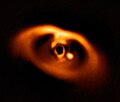Characteristics
Mass, radius and temperature
Kepler-419b is a hot Jupiter, an exoplanet that has a radius and mass near that of the planet Jupiter, but with a much higher temperature. It has a temperature of 505 K (232 °C; 449 °F). [2] It has a mass of 2.5 MJ and a radius of 0.96 RJ.
Host star
The planet orbits an (F-type) star named Kepler-419. The star has a mass of 1.39 M☉ and a radius 1.75 R☉. It has a surface temperatures of 6430 K and is 2.8 billion years old. In comparison, the Sun is about 4.6 billion years old [3] and has a surface temperature of 5778 K. [4]
The star's apparent magnitude, or how bright it appears from Earth's perspective, is 13. It is too dim to be seen with the naked eye.
Orbit
Kepler-419b orbits its host star with 270% of the Sun's luminosity (2.7 L☉) about every 67 days at a distance of 0.37 AU (close to the orbital distance of Mercury from the Sun, which is 0.38 AU). It has a highly eccentric orbit, with an eccentricity of 0.833.
Discovery
In 2009, NASA's Kepler spacecraft was completing observing stars on its photometer, the instrument it uses to detect transit events, in which a planet crosses in front of and dims its host star for a brief and roughly regular period of time. In this last test, Kepler observed 50000 stars in the Kepler Input Catalog, including Kepler-419, the preliminary light curves were sent to the Kepler science team for analysis, who chose obvious planetary companions from the bunch for follow-up at observatories. Observations for the potential exoplanet candidates took place between 13 May 2009 and 17 March 2012. After observing the respective transits, the first planet, Kepler-419b, was announced. [1]
This page is based on this
Wikipedia article Text is available under the
CC BY-SA 4.0 license; additional terms may apply.
Images, videos and audio are available under their respective licenses.



